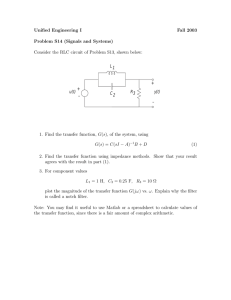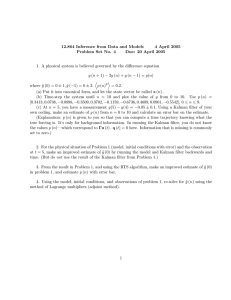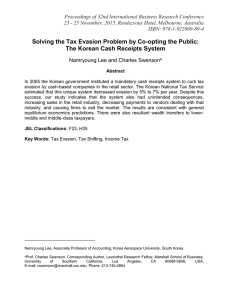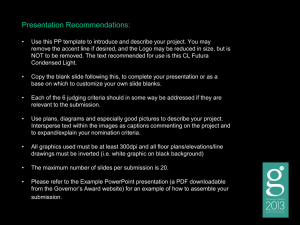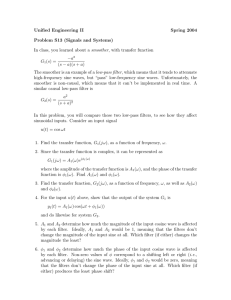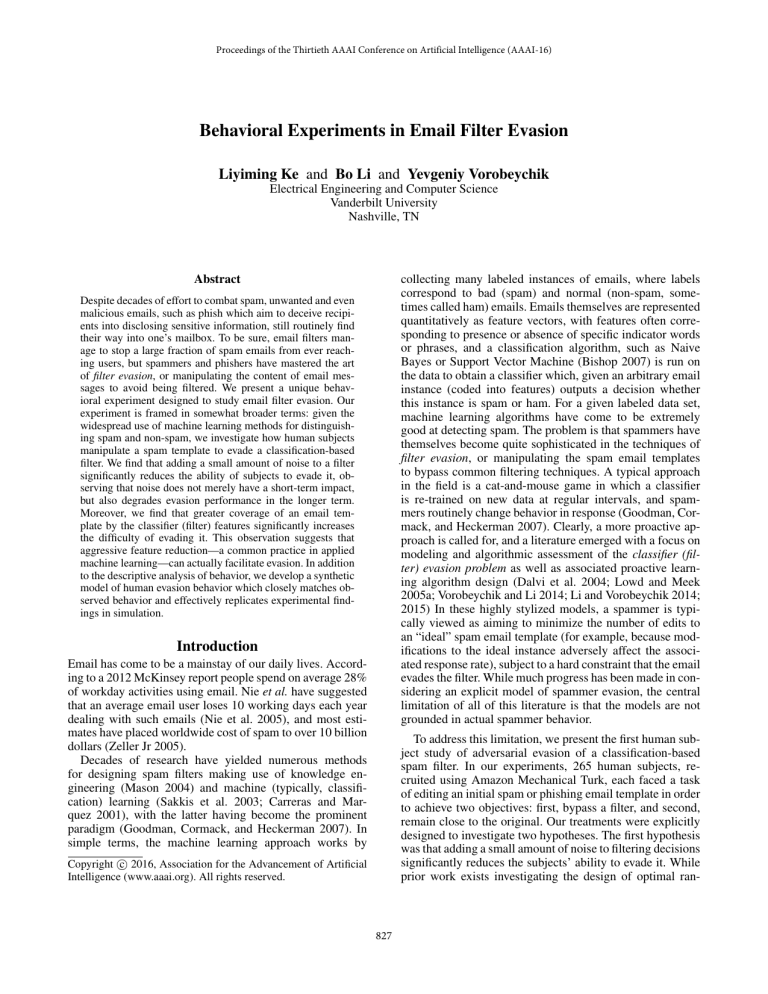
Proceedings of the Thirtieth AAAI Conference on Artificial Intelligence (AAAI-16)
Behavioral Experiments in Email Filter Evasion
Liyiming Ke and Bo Li and Yevgeniy Vorobeychik
Electrical Engineering and Computer Science
Vanderbilt University
Nashville, TN
collecting many labeled instances of emails, where labels
correspond to bad (spam) and normal (non-spam, sometimes called ham) emails. Emails themselves are represented
quantitatively as feature vectors, with features often corresponding to presence or absence of specific indicator words
or phrases, and a classification algorithm, such as Naive
Bayes or Support Vector Machine (Bishop 2007) is run on
the data to obtain a classifier which, given an arbitrary email
instance (coded into features) outputs a decision whether
this instance is spam or ham. For a given labeled data set,
machine learning algorithms have come to be extremely
good at detecting spam. The problem is that spammers have
themselves become quite sophisticated in the techniques of
filter evasion, or manipulating the spam email templates
to bypass common filtering techniques. A typical approach
in the field is a cat-and-mouse game in which a classifier
is re-trained on new data at regular intervals, and spammers routinely change behavior in response (Goodman, Cormack, and Heckerman 2007). Clearly, a more proactive approach is called for, and a literature emerged with a focus on
modeling and algorithmic assessment of the classifier (filter) evasion problem as well as associated proactive learning algorithm design (Dalvi et al. 2004; Lowd and Meek
2005a; Vorobeychik and Li 2014; Li and Vorobeychik 2014;
2015) In these highly stylized models, a spammer is typically viewed as aiming to minimize the number of edits to
an “ideal” spam email template (for example, because modifications to the ideal instance adversely affect the associated response rate), subject to a hard constraint that the email
evades the filter. While much progress has been made in considering an explicit model of spammer evasion, the central
limitation of all of this literature is that the models are not
grounded in actual spammer behavior.
Abstract
Despite decades of effort to combat spam, unwanted and even
malicious emails, such as phish which aim to deceive recipients into disclosing sensitive information, still routinely find
their way into one’s mailbox. To be sure, email filters manage to stop a large fraction of spam emails from ever reaching users, but spammers and phishers have mastered the art
of filter evasion, or manipulating the content of email messages to avoid being filtered. We present a unique behavioral experiment designed to study email filter evasion. Our
experiment is framed in somewhat broader terms: given the
widespread use of machine learning methods for distinguishing spam and non-spam, we investigate how human subjects
manipulate a spam template to evade a classification-based
filter. We find that adding a small amount of noise to a filter
significantly reduces the ability of subjects to evade it, observing that noise does not merely have a short-term impact,
but also degrades evasion performance in the longer term.
Moreover, we find that greater coverage of an email template by the classifier (filter) features significantly increases
the difficulty of evading it. This observation suggests that
aggressive feature reduction—a common practice in applied
machine learning—can actually facilitate evasion. In addition
to the descriptive analysis of behavior, we develop a synthetic
model of human evasion behavior which closely matches observed behavior and effectively replicates experimental findings in simulation.
Introduction
Email has come to be a mainstay of our daily lives. According to a 2012 McKinsey report people spend on average 28%
of workday activities using email. Nie et al. have suggested
that an average email user loses 10 working days each year
dealing with such emails (Nie et al. 2005), and most estimates have placed worldwide cost of spam to over 10 billion
dollars (Zeller Jr 2005).
Decades of research have yielded numerous methods
for designing spam filters making use of knowledge engineering (Mason 2004) and machine (typically, classification) learning (Sakkis et al. 2003; Carreras and Marquez 2001), with the latter having become the prominent
paradigm (Goodman, Cormack, and Heckerman 2007). In
simple terms, the machine learning approach works by
To address this limitation, we present the first human subject study of adversarial evasion of a classification-based
spam filter. In our experiments, 265 human subjects, recruited using Amazon Mechanical Turk, each faced a task
of editing an initial spam or phishing email template in order
to achieve two objectives: first, bypass a filter, and second,
remain close to the original. Our treatments were explicitly
designed to investigate two hypotheses. The first hypothesis
was that adding a small amount of noise to filtering decisions
significantly reduces the subjects’ ability to evade it. While
prior work exists investigating the design of optimal ran-
c 2016, Association for the Advancement of Artificial
Copyright Intelligence (www.aaai.org). All rights reserved.
827
g(x), which predicts a label for an arbitrary feature vector (email) x. Many techniques have been proposed for this
problem. For our purposes, we used a Naive Bayes classifier, and used 500 features (words) that had the highest
(R)elative (F)requency in spam / non-spam emails respectively. The relative frequency for each word i is defined as
|RF−1 (i) − RF+1 (i)|, where RFC (i) is the relative frequency that word i appears in instances x in class C. We
used TREC data to train the classifier with the average accuracy of ∼91% in five-fold cross-validation.
Given a classifier, g(x), adversarial evasion is commonly
modeled as (an adversary) choosing another feature vector
x (for example, a modified spam email template) which is
classified as benign and is as close to the original instance
x as possible (Lowd and Meek 2005a; Nelson et al. 2012;
Li and Vorobeychik 2014). Formally, let c(x, x ) be a cost
function representing the loss sustained by the adversary
from choosing x instead of x. The adversary is solving the
following optimization problem:
domization schemes in adversarial settings (Paruchuri et al.
2008; Pita et al. 2009), including work involving human subjects (e.g., (Pita et al. 2010)), ours is the first to investigate
how randomization affects decision efficacy, and is also the
first to consider randomization in experimental investigation
of spam filter evasion. The second hypothesis was that measuring distance to the original in a way that does not penalize the subjects for making word substitutions, such as using
synonyms, will significantly improve their performance. We
find strong support for the first hypothesis, whereas, somewhat surprisingly, the support for the second hypothesis is
mixed. In particular, we observe that randomized filtering
significantly reduces the ability of subjects to evade, largely
because it significantly increases the fraction of times that
participants’ submissions were filtered by the system. An
additional finding of great practical importance is that increasing the fraction of words in an original email that are
included as features in the classifier (filter) also increases
the difficulty of the associated task. One of the core guiding principles in applied machine learning is that one should
keep the number of features used as small as possible. Our
finding, in contrast, suggests that when faced with an adversarial classification problem, such as spam filtering, limiting
the number of features can actually make the evasion problem easier.
In addition to our experimental findings, we developed
a synthetic model of evasion behavior calibrated using the
experimental data. We demonstrate that our model effectively predicts both individual-level behavior, as well as aggregate experimental quantities, allowing us to successfully
replicate the experimental findings in simulation. Our synthetic model can thus be utilized in follow-up development
of proactive spam filtering methods that explicitly account
for human evasion behavior.
min
x |g(x )=−1
c(x, x ).
The simplest way to measure this cost is by using a norm,
commonly, l1 , giving rise to the following cost function:
|xi − xi |,
S1 : c(x, x ) =
i
where i ranges over the features. In recent work, this cost
function has been criticized on the grounds that it penalizes
for substitutions among equivalent features (for example,
synonyms or 1-letter substitutions in words) (Li and Vorobeychik 2014). This work proposed an alternative cost function defined as follows:
min
|xj − xi |,
S2 : c(x, x ) =
i
Preliminaries
j∈Fi |xj ⊕xj =1
where xi denotes the ith feature within the instance x; Fi
is the equivalence class (i.e., the set of equivalent features)
for a feature xi ; and ⊕ represents the exclusive-or to guarantee that the features are substituted instead of only being
deleted. In our experiments we defined the equivalence class
of a word to be its synonyms (evaluated using the semantic dictionary WordNet (Miller et al. 1990)) and 1- and 2character substitutions.
Before we can properly describe and motivate the experimental setup, we begin by considering in the abstract the
problem of adversarial classifier evasion, which has been
previously studied in several forms from a computational
standpoint (Lowd and Meek 2005b; 2005a; Vorobeychik and
Li 2014; Li and Vorobeychik 2014). Spam and phishing
email filtering is a special case: when machine learning is
used to filter spam emails, the spammer changes the email
structure (template) in order to evade the filter to ensure successful delivery of the email. The crucial challenge is that
evasion alone is not sufficient: one needs to ensure that the
original purpose of the email is still fulfilled. Next, we describe how this tradeoff can be quantified.
An instance of interest, such as an email (which may
or may not be spam) is represented as a vector of binary features, x = {x1 , . . . , xn }. The corresponding label
is encoded as either +1, signifying a malicious instance
(spam, for example), or −1, signifying a normal or benign instance (a regular email). In using machine learning
for spam/phishing detection, we start with a training data
set of instances {(xi , y i )} where xi are the feature vectors
and y i are the corresponding labels, and train a classifier,
Experiment Design
Since we intend to study adversarial evasion of spam filters
which use classification learning, our ideal source of subjects is spammers or phishers.1 It is clearly infeasible to obtain enough subjects from this population for an experiment.
As a proxy, we use human subjects recruited using Amazon Mechanical Turk, a popular crowd-sourcing platform
that is commonly utilized by behavioral science researchers
1
We are assuming that spam filter evasion, and, indeed, evasion
of machine learning methods in general, is largely a manual process. To our knowledge, no general-purpose tools exist to automate
such a process, although theoretical models of spammer evasion
have received some attention, as described above.
828
to recruit and pay human subjects (Von Ahn and Dabbish
2008). While not ideal, there is now substantial evidence
that results from the experiments using Amazon Mechanical Turk are often indistinguishable from those found in
physical laboratories (Horton, Rand, and Zeckhauser 2011;
Suri and Watts 2011). To collect data, we built a Rails application and ran it on the Amazon Web Services EC2, while
storing data on Amazon Web Services RDS. In all, we recruited 265 participants for the study who have jointly completed 482 tasks (described below), with each subject performing at most two tasks, both necessarily distinct. No task
could be repeated by the same subject.
After signing up for the experiment, each participant received a simple and brief English language test (see the
Supplement for details).2 Passing this test qualified them
for participation in the experiment. At this point, subjects
were invited to read the tutorial describing the experimental setup (see the Supplement for details). A participant was
randomly assigned two tasks (corresponding to experimental treatments). Each task entailed a sequence of 20 submissions of manipulated instances of an “ideal” email by the
subjects.3 For each submission the subjects saw an interface
similar to the one shown in Figure 1.
2. a classifier filtering submissions, not visible to the subjects, and
Figure 1: Example interface. The left window is the original or “ideal” email. The right window is a free text form
for the submission. Once the participant has written the new
email (which may involve copying and pasting portions of
the original on the left), they click “Submit” to submit it to
the system for scoring. In this case, the prior submission bypassed the filter, receiving a score of 57. The participant can
make at most 20 submissions. In this example, the participant has made 10 submissions thus far, with 10 more remaining.
Results
3. a scoring function, not visible to the subjects.
An “ideal” email instance corresponds in the evasion model
above to the ideal feature vector x; in order to maximize
their score, the subjects had to craft an email which was
close to this ideal. Ideal instances for the experiments were
chosen from 10 pre-selected spam and phishing emails (see
the Supplement for details). The actual classifier used in
each task was fixed to the model described above. What we
varied was whether or not noise was added to a classification output g(x) for a given instance (submission) x. Specifically, in the “noise” treatment the output of the classifier
was flipped with 10% probability. The baseline (no noise)
treatment, on the other hand, used the classifier as is for all
submissions. Finally, the scoring function was chosen uniformly at random between S1 and S2 described above. The
subjects were not initially told the specifics of the classifier (nor whether or not it included noise) or of the scoring
function (they could request this information after the experiment).
After each submission, a participant received immediate
feedback about whether or not the submission was filtered
(filtered submissions received zero score), and, if it was not
filtered, the score of their last submission, as well as their
current best score. For a given submission e, if the cost
function (randomly chosen for that task) evaluated to c, the
score was calculated as r(e) = 100 × e−1.5c . The best score
obtained over all 20 submissions, rmax , was used to determine their payment. Specifically, payment for a task was in
the range $1 − $5, with the actual payment computed as
$1 + 0.04 × rmax .
Because individual tasks elicited highly divergent performance by the subjects, our reported results use normalized
r(t)−low(i)
scores, S(t, i) = 90 high(i)−low(i)
+ 10, where high(i) and
low(i) represents the highest and lowest score among all
submissions for task i, respectively.
Randomization makes evasion more difficult
Since we randomly assigned subjects to randomized vs. nonrandomized classifier treatments, we are able to definitively
establish the impact that adding a small amount of noise to
the filter has on the ability of subjects to evade it. Table 1
supports the hypothesis that adding noise to a filter reduces
the effectiveness of human subjects to evade it.
Category
Noise-Free Filter
Noisy Filter
Each task/treatment included three randomly generated
pieces:
1. An “ideal” email instance, visible to the subjects,
S1
24.02
19.98
S2
30.06
20.58
Overall Average
26.87
20.29
Table 1: Average subject scores for the two scoring functions
in the noise-free and noisy filter treatments.
2
Online supplement can be found at http://vorobeychik.com/
2016/evasionSupplement.pdf.
3
The first five submissions were “trials” and were not used towards calculating the final score.
In particular, the overall average for the noise-free filter
is over 30% higher than when noise is added. This result is
829
statistically significant (p < 0.01). Moreover, the result remains significant for the two scoring functions individually.
In addition, we find that the scoring function S2 which does
not penalize for substitutions tends to yield higher scores for
the subjects. This effect is substantial (25% improvement in
average normalized score) and significant (p < 0.01) in the
noise-free filter treatments. Surprisingly, the effect is quite
small (3%) and not statistically significant when noise is
present. Next we delve deeper in the details of participant
behavior to try to shed some light on these results.
The most natural hypothesis into why randomization has
a significant impact on the ability to evade the filter is that
it makes the task of learning how the filter operates significantly more challenging. The subject behavior bears this
out: 77% of submissions were filtered in the noise-free environment, compared to 82% when noise was present (the
comparison is significant with p < 0.01). Expanding this result by submission (Figure 2), we can observe that not only
does the noise-free environment appear to promote much
faster learning of how to evade a classifier by the subjects,
but the relative difference appears to increase with experience (even as there is clear indication of learning to evade
in both cases). Interestingly, we did not observe a similar
setting. In this model we consider four variables: a binary
indicator whether or not a previous submission was flipped
(due to noise), the number of prior submission that were
flipped, the submission number (higher number indicates a
later submission and thereby indicates greater experience),
and feature density (fraction of the words in the “ideal”
email that are features in the classification-based email filter). The results are shown in Table 2. Here x1 is a binary
x1
x2
x3
x4
constant
Coefficient
3.11
0.38
-0.39
7.85
-1.53
Std Error
0.15
0.025
0.021
1.11
0.33
z
21
15
-18
7.1
-4.7
p-value
< 0.01
< 0.01
< 0.01
< 0.01
< 0.01
Table 2: Results of the logistic regression model for the
probability of a filtered submission.
indicator whether or not a previous submission was flipped
(due to noise). x2 is the number of prior submission that
were flipped. x3 is the submission number. x4 is the feature density (fraction of the words in the “ideal” email that
are features in the classification-based email filter). While
all coefficients are highly significant, of particular interest
are the first two: whether the prior submission was flipped,
and the number of previously flipped submissions. The former increases log-odds by 3.11, or increasing the odds ratio
(probability of failed evasion divided by probability of success) by more than 20. Thus, it is quite clear that adding a
noise to a particular submission results in a substantial shortterm impact on the ability to evade a classifier. In addition,
there is a significant longer-term impact: each flip increases
the odds ratio of failure to success for any subsequent submission by ∼1.5.
Next, we turn to the issue of the impact that a substitutionaware scoring function (S2 ) has on performance by considering two micro-level manipulations that participants performed to the “ideal” email as well as subsequent submissions: word additions and deletions. We first look at how
these evolved over time.
Figure 3 shows that the first several submissions exhibit
considerable manipulation, but after the third submission,
the numbers of both additions and deletions remains relatively stable, with slightly fewer words added than deleted
in each submission except the first few.
Overall, we found the number of additions to be higher
than deletions (p < 0.01). We can also observe that additions comprise a significant fraction of the previous submission, in many cases over 40% of the content. In contrast, the
fraction of words deleted was typically around 20%. (The
rest of the content is, of course, unchanged from the previous submission). Taking the deletions and additions together, we next compare the total number of edits for the
noise-free and noisy filter settings. When no noise is added
to the filter, the subjects made, on average, nearly 48 edits per submission. In contrast, when noise was present, this
number dropped to 45.86 (the difference is significant with
p < 0.01): somewhat surprisingly, this indicates that the
Figure 2: Fraction of submissions that were filtered in the
noise-free setting (the blue lower line) and when noise was
randomly added to filter output (the red higher line).
pattern when it came to scores received on non-filtered submissions (filtered submissions, of course, received a score
of zero) or in time taken to make a decisions: in both cases,
differences were not significant between the noise-free and
noisy settings, and there was no clear long-term trend. Thus,
for example, there was little evidence that scores earned on
non-filtered submissions improved with experience (see the
Supplement for details). Similarly, while the first few submissions took longer than others on average, thereafter the
overall trend with experience was minimal (see the Supplement for details). To sum up, it appears that the reduced ability to successfully evade the classifier was the primary effect
of randomization on evasion performance.
To further investigate the source of the difficulty that participants faced in the evasion task under randomization, we
consider a simple logistic regression model in which the output is the probability that a submission is filtered in the noisy
830
ence is negative (r(ei+1 ) − r(ei ) < 0). When these scores
are both zero, we say that feedback is null, whereas when
they are both equal and positive (r(ei+1 ) = r(ei ) > 0),
we call it equal. We find that receiving positive feedback on
prior submission leads subjects to spend more time on the
following submission (p < 0.01; see Figure 4), and obtain
a higher score. In contrast, receiving null or equal feedback
leads to less time spent on the following submission. This
observation is quite surprising: one would think that particularly null feedback (corresponding to several filtered submissions in a row) would cause the subjects to spend more
time contemplating a better evasion strategy, but we see the
opposite. Interestingly, our findings are consistent with Mason and Watts (2012). Briefly, Mason and Watts consider a
problem of exploring a complex landscape in human subject experiments on a network, where participants could observe what their network neighbors have found. One of their
key findings is that when a subject’s neighbors find good
solutions, the subject engages in significantly more exploration of the landscape. Taken together, their findings and
ours suggest that positive feedback serves as an important
psychological motivator of engagement in a task, which in
turn improves performance.
Figure 3: Additions and deletions of words to prior submission over time (i.e., over a sequence of submissions). The
number of additions is the lower light blue bar, and the heavy
blue line represents additions as a fraction of total number
of words in the prior submission. The number of deletions
is the purple bar at the top, and the dashed green line corresponds to the deletions as a fraction of words in the prior
submission.
Feature reduction makes adversarial evasion easier
participants were engaged is slightly less exploration in the
noisy-filter treatments, accounting to some extent for the fact
that they had significantly more trouble evading the filter in
this setting. Moreover, we found that the total fraction of edits which involved substitutions was significantly higher in
the noise-free treatment (0.52 vs. 0.47; p < 0.01). Again,
this points to significantly increased activity and engagement by the subjects in the noise-free treatment (and, perhaps, less confusion about how to effectively manipulate the
template). In addition, this helps explain the surprising result
that the difference between S2 and S1 treatments was much
smaller when noise was present: the substitution-aware scoring function S2 will reward subjects especially for using
substitutions in their manipulations, and these were far more
prominent under the noise-free treatment.
While substitutions clearly played an important role in
subject behavior under all treatments, the composition was
somewhat surprising: synonyms accounted for less than 3%
of all edits, as compared to character substitutions, which
amounted to over 45% of edits. Although some of the character substitutions may have been incidental, rather than
deliberate (many words are only a few characters apart),
many were clearly deliberate; for example, over 22% of 2character substitutions cannot be found in the dictionary,
suggesting that subjects deliberately misspelled words to
evade the classifier.
There was significant variability among the 10 tasks (original “ideal” emails) in terms of apparent difficulty of evasion.
To understand the source of this variability, we consider the
relationship between feature density, or the fraction of words
in the ideal instance which are used as features in the classifier (filter), and average as well as maximum score for the
task.
Figure 4 shows that higher feature density leads to a lower
score, appearing to make evasion more difficult for the subjects. Table 2, which features a logistic regression model of
Positive feedback improves engagement in the task
Figure 4: The relationship between maximum and average
score for each task and the feature density of the corresponding “ideal” email. Feature density is the fraction of words in
the ideal email that correspond to features in the classifier
(filter).
Next we investigate the extent to which receiving a positive
feedback on prior submission impacts human subject performance. We quantify feedback as the difference between
the score for prior submission r(ei+1 ) and the score received for the immediately preceding submission r(ei ). We
say that feedback is positive when this difference is positive
(r(ei+1 ) − r(ei ) > 0), and it is negative when this differ-
the probability that a submission is filtered, offers stronger
831
evidence: the coefficient corresponding to feature density is
again high and significant (and with submission-level granularity we now have much more data to justify this conclusion): it seems clear that increasing feature density makes
adversarial evasion far more challenging.
The observation that increased feature density increases
difficulty of evasion has important ramifications for the
use of machine learning tools in spam/phish filtering tasks
specifically, and intrusion detection more generally. One of
the most important “best practice” principles in applied machine learning is feature reduction, or limiting the total number of features used, for example, through the use of regularization or other means of feature selection (Bishop 2007).
Clearly, when we reduce the size of the feature set used for
filtering, we also reduce feature coverage of spam instances,
that is, we reduce feature density. Our observation here suggests, therefore, that feature reduction can make adversarial
evasion easier.
flipped in each iteration based on the model prediction. This
process results in a sequence of feature vectors generated by
the model, which were then scored as described above to
obtain the values in the table. Comparison to Table 1 suggests that the results of the synthetic model closely mirror
actual observations of subject behavior in the experiment.
In addition, we compare in Figure 5 predicted and actual
average normalized scores by submission for randomized
(noise-free) and non-randomized filters. The predicted and
Synthetic model of human evasion behavior
One of our motivations for engaging in human subject evasion experiments was to develop and calibrate a synthetic
model of evasion dynamics. We propose the following composite model of behavior:
1. For each feature predict (independently of other features)
whether its value is changed, and
2. For each feature word which is predicted to be deleted,
predict whether it is substituted for (we assume that substitutions are chosen outside of the feature vector).
For task (1) we develop n independent dynamical models,
one corresponding to each binary feature of the classifier, to
predict the evolution of the feature vector with the sequence
of individual submissions using a Support Vector Machine
(SVM) (Bishop 2007). Features used for this prediction task
were taken from a combination of features for the previous
two submissions, demographics, as well as feedback, including previous score and whether or not the prior submissions
were filtered. For task (2) we developed an independent
SVM model for each deleted word predicting occurrence of
a substitution. Our models were able to recover underlying
behavior with high accuracy in cross-validation (average accuracy was over 97%). However, this in itself is an insufficient criterion for our purposes: a useful dynamic model of
behavior should also successfully replicate the experimental
findings described earlier, both qualitatively and quantitatively. To exhibit that the model successfully does so, Table 3
Category
Noise-Free Filter
Noisy Filter
S1
28.63
20.51
S2
31.61
21.08
Figure 5: Comparison between experimentally observed
scores and those based on the synthetic model of behavior as
a function of the submission sequence for noisy and noisefree settings.
observed average scores match rather closely (nearly perfect
correlation and small mean-squared error), and the expected
gap between randomized and non-randomized is clearly visible in simulated behavior just as it is in real.
Discussion
Machine learning algorithms have come to be used widely
in settings which involve inherently adversarial interactions.
One of the most important such settings is spam and phishing email filtering, where evasion has been an important
and well documented consideration (Goodman, Cormack,
and Heckerman 2007; Colbaugh and Glass 2012). Our results offer both qualitative practical guidance for the design
of robust email filtering systems based on machine learning
methods, and explore human behavior in the context of adversarial interaction with a machine learning system. In particular, we can offer several practical pieces of advice: first,
filtering systems should embed a small amount of noise in
order to increase the level of difficulty for spammers and
phishers in designing templates to evade these systems; and
second, special care must be taken in training classifiers for
such systems to not be overly aggressive in removing “unnecessary” features. Of course, in both cases one should not
over-compensate: introducing noise into classification decisions necessarily decreases accuracy, and the system designer must balance this degradation with increased robustness to adversarial evasion. Similarly, while our experiments
demonstrate the perils of reducing the feature space too aggressively, one clearly must also consider the traditional is-
Overall Average
29.94
20.75
Table 3: Predicted average subject scores for the two scoring
functions in the noise-free and noisy filter treatments.
shows the predicted results of our 2x2 treatment (noise-free
vs. noisy filter, S1 vs. S2 scoring). To generate these results,
the synthetic model was run starting from the ideal email instance, where features were deterministically chosen to be
832
Li, B., and Vorobeychik, Y. 2015. Scalable optimization
of randomized operational decisions in adversarial classification settings. In International Conference on Artificial Intelligence and Statistics. to appear.
Lowd, D., and Meek, C. 2005a. Adversarial learning. In
Proceedings of the eleventh ACM SIGKDD international
conference on Knowledge discovery in data mining, 641–
647. ACM.
Lowd, D., and Meek, C. 2005b. Good word attacks on statistical spam filters. In CEAS.
Mason, W., and Watts, D. J. 2012. Collaborative learning in
networks. Proceedings of the National Academy of Sciences
109(3):764–769.
Mason, J. 2004. The spamassassin homepage. http.
V/Spamassassin. org/index. html.
Miller, G. A.; Beckwith, R.; Fellbaum, C.; Gross, D.; and
Miller, K. J. 1990. Introduction to wordnet: An on-line
lexical database*. International journal of lexicography
3(4):235–244.
Nelson, B.; Rubinstein, B.; Huang, L.; Joseph, A.; Lee, S.;
Rao, S.; and Tygar, J. D. 2012. Query strategies for evading
convex-inducing classifiers. Journal of Machine Learning
Research 13:1293–1332.
Nie, N. H.; Simpser, A.; Stepanikova, I.; and Zheng, L.
2005. Ten years after the birth of the internet, how do americans use the internet in their daily lives. Stanford Institute
for the Quantitative Study of Society.
Paruchuri, P.; Pearce, J. P.; Marecki, J.; Tambe, M.; Ordóñez,
F.; and Kraus, S. 2008. Playing games with security: An
efficient exact algorithm for Bayesian Stackelberg games.
In Proceedings of the Seventh International Conference on
Autonomous Agents and Multiagent Systems, 895–902.
Pita, J.; Jain, M.; Ordóñez, F.; Portway, C.; Tambe, M.;
Western, C.; Paruchuri, P.; and Kraus, S. 2009. Using
game theory for los angeles airport security. AI Magazine
30(1):43–57.
Pita, J.; Jain, M.; Ordonez, F.; Tambe, M.; and Kraus, S.
2010. Robust solutions to stackelberg games: Addressing
bounded rationality and limited observations in human cognition. Artificial Intelligence Journal 174(15):1142–1171.
Sakkis, G.; Androutsopoulos, I.; Paliouras, G.; Karkaletsis,
V.; Spyropoulos, C. D.; and Stamatopoulos, P. 2003. A
memory-based approach to anti-spam filtering for mailing
lists. Information Retrieval 6(1):49–73.
Suri, S., and Watts, D. J. 2011. Cooperation and contagion
in web-based, networked public goods experiments. PLoS
One 6(3):e16836.
Von Ahn, L., and Dabbish, L. 2008. Designing games with
a purpose. Communications of the ACM 51(8):58–67.
Vorobeychik, Y., and Li, B. 2014. Optimal randomized
classification in adversarial settings. In International Joint
Conference on Autonomous Agents and Multiagent Systems,
485–492.
Zeller Jr, T. 2005. Law barring junk e-mail allows a flood
instead. The New York Times 1.
sues of overfitting in designing robust and effective learning
systems in adversarial environments.
From the perspective of individual behavior, our findings
reinforce a surprising finding due to Mason and Watts (2012)
that observation of good outcomes (we call this positive
feedback) increases individual engagement in the task. Indeed, Mason and Watts contextualized this finding entirely
in a social network setting, whereas our results suggest that
this phenomenon is more fundamental.
Finally, our results have significant bearing on the substantial literature preoccupied with designing high-quality
randomization schemes in security (Paruchuri et al. 2008;
Pita et al. 2009; 2010; Jajodia et al. 2012) and machine learning (Vorobeychik and Li 2014; Li and Vorobeychik 2015). In
much of this work, randomization schemes are developed
under the assumption that the adversary is fully rational.
Our experiments demonstrate that randomization takes on
additional importance with a human adversary. In particular, the introduction of noise appears to significantly hamper the ability of the subjects to learn how to evade the
classification-based filter. Moreover, the effect of noise is not
merely short-term (immediately following the noisy feedback) but has a significant lasting impact on performance
well after the perturbation had been introduced.
Acknowledgments
This was was partially supported by the NSF (CNS1238959, IIS-1526860), ONR (N00014-15-1-2621), AFRL
(FA8750-14-2-0180), Sandia National Laboratories, and
Symantec Labs Graduate Research Fellowship.
References
Bishop, C. 2007. Pattern Recognition and Machine Learning. Springer.
Carreras, X., and Marquez, L. 2001. Boosting trees for antispam email filtering. arXiv preprint cs/0109015.
Colbaugh, R., and Glass, K. 2012. Predictive defense
against evolving adversaries. In IEEE International Conference on Intelligence and Security Informatics, 18–23.
Dalvi, N.; Domingos, P.; Sanghai, S.; Verma, D.; et al. 2004.
Adversarial classification. In Proceedings of the tenth ACM
SIGKDD international conference on Knowledge discovery
and data mining, 99–108. ACM.
Goodman, J.; Cormack, G. V.; and Heckerman, D. 2007.
Spam and the ongoing battle for the inbox. Communications
of the ACM 50(2):25–33.
Horton, J. J.; Rand, D. G.; and Zeckhauser, R. J. 2011. The
online laboratory: Conducting experiments in a real labor
market. Experimental Economics 14(3):399–425.
Jajodia, S.; Ghosh, A. K.; Subrahmanian, V.; Swarup, V.;
Wang, C.; and Wang, X. S., eds. 2012. Moving Target Defense II: Application of Game Theory and Adversarial Modeling. Springer.
Li, B., and Vorobeychik, Y. 2014. Feature cross-substitution
in adversarial classification. In Advances in Neural Information Processing Systems, 2087–2095.
833

